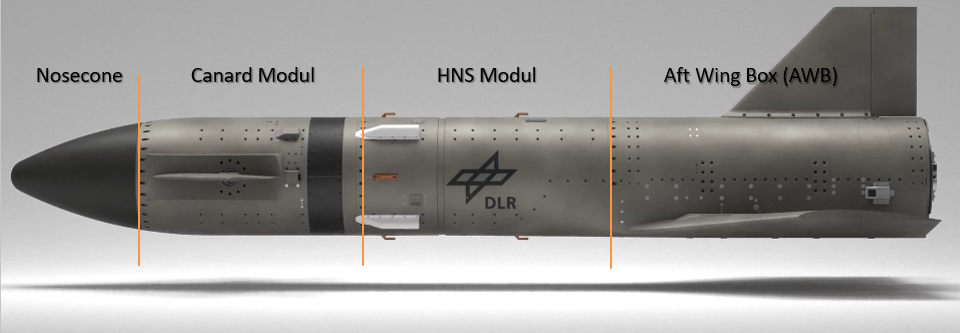ReFEx – Reusability Flight Experiment

ReFEx
Your consent to the storage of data ('cookies') is required for the playback of this video on Youtube.com. You can view and change your current data storage settings at any time under privacy.
Duration: 2017 - 2025
Launch vehicles are complex and expensive systems the costs of which cannot be spread over many missions if the vehicles are expendable. Therefore, worldwide research activities are ongoing to find solutions to reduce the cost of launch systems for future missions. Different concepts and technical products have been developed in the past or are still under development.
Currently, the German Aerospace Center (DLR) is working on realization of the Vertical Take-off Horizontal Landing (VTHL) Reusability Flight Experiment (ReFEx) since early 2017. The flight demonstration of ReFEx is planned by the end of 2026.
Additionally, DLR is performing system studies of full-scale Reusable Launch Vehicles (RLV) Vertical Take-off and Vertical Landing (VTVL) and VTHL stages to determine the effects of reusability regarding launcher operations, performance, costs and logistics. This puts DLR in the unique position of having access to flight data from both types of vehicles for future European launch vehicles. (DLR investigates the VTVL concept in the frame of the CALLISTO project, together with CNES and JAXA. The flight demonstration is planned for 2027.)
The main goals of the ReFEx project are:
- Perform a controlled flight following a re-entry trajectory representative for a winged RLV first stage in the velocity range hypersonic down to subsonic
- Perform a controlled heading change (capability required for returning to the launch site)
- Test of the autonomous Guidance Navigation and Control (GNC) system
- Perform In-Flight Data acquisition using advanced sensors
- Recovery the Re-Entry Segment for the Post Flight Analysis (PFA)
The ReFEx Launch configuration and the section view of the Re-Entry Segment (called ReFEx) is depicted below. The integrated units are grouped to the following subsystems:
- Guidance Navigation and Control (GNC)
- Avionics (AVS)
- Structure (STR)
- Flight Instrumentation (FIN)
System Overview
The figure below illustrates the payload placed on top of the DCTA VSB-30 sounding rocket as well as the re-entry segment as foreseen for the re-entry flight. The VSB-30 has a passive stabilization system. Therefore, the payload requires to have an almost rotationally symmetrical shape. In case of the re-entry segment, it needs to have an aerodynamic shape for the experimental descent phase. To meet both requirements the wings of the flight vehicle are designed to be foldable and are covered by a split fairing for the atmospherically ascent passage.
The current design of the Re-Entry Segment has a length of 2.7 m, a wingspan of 1.1 m, and a total mass of about 400 kg.
The mechanical and aerothermal loads for the structural design are usually based on flight trajectory analysis, in this case on the Reusable Launch Vehicle (RLV) trajectory. The structural design as well as the Thermal Protection System (TPS) design are made based on previous DLR flight experiences considering the velocity of the re-entry segment at approx. Mach 5 and a short flight duration of approx. 10 min. The fuselage including the control surfaces comprise a classical metallic structure. A dedicated local TPS will be foreseen. Among other things, these structural parts including digital analyses are designed and performed by our institute (orange framed parts).

Beside the payload adapter, the three-split fairing including separation system and the overall re-entry segment (prime fuselage) also the design of the inner secondary structure with a new developed semi-free-floating attachment system, for thermal compensations is developed by our institute in the department of Space System Integration.

One of the main challenges is the static as well as the dynamic stability of the vehicle in all flight regimes during re-entry flight. To be able to follow the RLV trajectory, the angles of attack (AoA) need to be changed rapidly. These pose demanding requirements to the vehicles aerodynamic design as well as to the GNC subsystem. Furthermore, the acquisition of in-flight data using advanced sensors has a high priority. Therefore, the experimental vehicle is equipped with a number of specific sensors to perform continuous in-situ data acquisition of the environment and vehicle state itself.

Mission Design
The following picture shows schematically the sequence of the ReFEx mission with preliminary details regarding time and altitudes. After ignition and lift-off, the first stage (S31) is burned up and is separated. About 20 (s) after launch, the second stage (S30) will be ignited. Subsequently the fairing will be jettisoned. Then, the folding mechanisms will deploy the wings including a wing lock for descent position. Subsequently, the re-entry segment will be separated from the payload adapter. After separation, the control elements (canards, rudder, Reaction Control System (RCS)) will be unlocked. The RCS system however contributes to the control of the vehicle down to an altitude of ca. 50 km. Subsequently the re-entry segment is controlled by the aerodynamic control surfaces only. The re-entry vehicle does not show sufficient natural longitudinal and lateral stability in belly-down configuration for higher Mach numbers. In order to avoid these unstable flight regimes, the vehicle performs a ballistic flight, entering the corridor in belly-up orientation. In the range of Mach 2-1.5 the re-entry segment will perform a roll manoeuver. After the roll, the vehicle will remain in belly-down orientation for the rest of the mission. The roll manoeuver ensures sufficient natural stability and controllability of the Re-Entry Segment throughout the mission.

At an altitude of ca. 10 km the vehicle will enter a dispersion ellipsoid which initiates the End of Mission (EoM). To reduce the kinetic energy of the re-entry segment prior to touch down a flare manoeuver shall be performed at an altitude of ca. 120 m over ground.
The launch will carry out by DLR, DCTA and Southern Launch Ltd. Koonibba, Australia.






